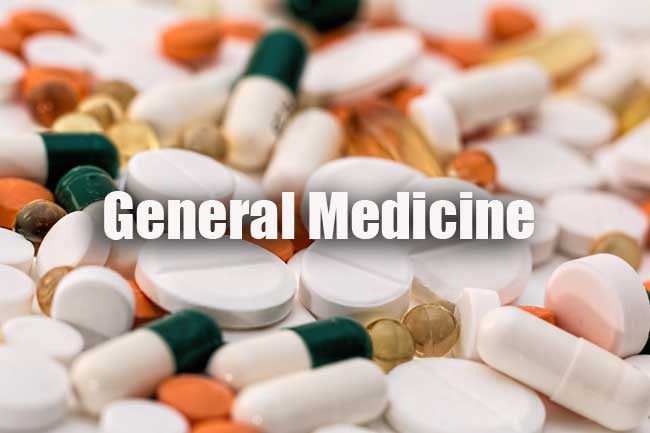General Medicine Practice Set
General Medicine Practice Set paper for the written examination is given below. Candidates who are looking for General Medicine exam Practice Set paper can find in this section. The applied candidates who are getting prepared for the General Medicine can view this page for the General Medicine Last Ten Years Practice Set Papers.

Download the General Medicine Practice Set & Solutions & make it as a reference for your exam preparation. Take advantage of these General Medicine Practice Set Papers in a proper manner to get qualifying Marks. Last 5 years General Medicine Practice Set Papers provided here. Candidates who are applied for the above exam can check and download the General Medicine Practice Set Papers from here.
Practice Set of General Medicine
1. Koplik’s spots is seen in
(1) Rubella
(2) Measles
(3) Infective endocarditis
(4) Herpes zoster
2. Ghon’s complex is not characterized by
(1) Pleural effusion
(2) Hilar lymphnodes
(3) Prominent draining lymphatics
(4) Subpleural Ghon focus
3. Which of the following antitubercular drug is not hepatotoxic ?
(1) Isoniazid
(2) Rifampicin
(3) Ethambutol
(4) Pyrazinamide
4. The most common ophthalmic lesion in AIDS
(1) Cotton Wool spots
(2) Roth spots
(3) Retinal haemorrhages
(4) Microaneurysms
5. Which drug is recommended for prevention of mother to child transmission of HIV infection ?
(1) Stavudine
(2) Nevirapine
(3) Indinavir
(4) Didanosine
6. The classic triad of signs suggestive of congenital toxoplasmosis includes all except
(1) Chorioretinitis
(2) Hydrocephalus
(3) Intracranial calcification
(4) Cerebral atrophy
7. Botulinum toxin is used in treatment of
(1) Facial dystonia
(2) Tetanus
(3) Guillan Bairre Syndrome
(4) Hypotonia
8. Linear calcification of ascending aorta is a characterisitc feature of
(1) Atherosclerosis
(2) Syphilis
(3) Marfan’s syndrome
(4) Takayasu arteritis
9. All the following drugs are used for eradication of Helicobacter pylori except
(1) Bismuth citrate
(2) Clarithromycin
(3) Metronidazole
(4) Sucralfate
10. Commonest complication of subacute bacterial endocarditis
(1) Congestive cardiac failure
(2) Myocardial abscess
(3) Mycotic aneurysms
(4) Cardiac arrhythmias
11. Proximal bronchiectasis, eosinophila and asthma is seen in
(1) Aspergillosis
(2) Histoplasmosis
(3) Cryptococcosis
(4) Blastomycosis
12. Winter bottom’s sign is typically seen in
(1) Leptospirosis
(2) Kalaazar
(3) Kawasaki disease
(4) African trypanosomiasis
13. Visceral Larva Migrans is caused by
(1) Toxoplasmosis
(2) Amoebiasis
(3) Toxocara canis
(4) Kalaazar
14. Nascher’s criteria defining geriatric syndromes are all except
(1) Commonness of the health problem
(2) Single etiology
(3) Increased morbidity and mortality
(4) Functional or cognitive impairment
15. Fried’s physical phenotype of fraility include all except
(1) Weak grip strength
(2) Unintentional weight loss >5 kg in 1 year
(3) Self reported exhaustion
(4) Low level of physical activity
16. Using muscle mass as an indicator, prevalence of sarcopenic obesity ranges between
(1) 1-3%
(2) 4-12%
(3) 12-18%
(4) 18-24%
17. Sleep problems of older people are all except
(1) Insomnia
(2) Restless leg syndrome
(3) Obstructive sleep apnoea
(4) None of the above
18. The mother of geriatrics is
(1) Mother Teresa
(2) Dr. Marjorie Warren
(3) Mrs. Bernard Isaac
(4) Dr. Fried
19. For Gestational hypertension all are true except
(1) New onset hypertension in pregnancy without proteinuria
(2) Occurs after 20 weeks of pregnancy
(3) Progress to preeclampsia in about 75% of cases
(4) Blood pressure normalizes by 12 weeks’ postpartum
20. Typical features of pubertal polycystic ovarian disease is all except
(1) Obesity
(2) Menstrual disturbances
(3) Insulin sensitivity
(4) Hyperandrogenism
| Practice Set | MCQs |
| Quiz | Questions and Answers |
| Previous Papers | Sample Question |
21. Asia’s first female neurosurgeon is
(1) Dr. Kanaka
(2) Dr. Shanta
(3) Dr. Soumya Swaminathan
(4) Dr. Asima Chatterjee
22. Physiological changes during pregnancy are all except
(1) Hypercoagulability
(2) Increased cardiac output
(3) Increased heart rate
(4) Increased systemic vascular resistance
23. The aging alterations include all except
(1) Increased bone marrow cellularity
(2) Telomere shortening
(3) Reduced haemoglobin
(4) Sarcopenia
24. Giant ‘a’ waves in Jugular Venous Pulse (JVP) occurs in all except
(1) Tricuspid regurgitation
(2) Ventricular Ectopics
(3) Junctional rhythm
(4) Complete heart block
25. Third heart sound (S3) is not heard in
(1) High cardiac output states
(2) Ventricular aneurysm
(3) Mitral regurgitation
(4) Ventricular Septal defect
26. Normal H-V interval measured from H deflection on His electrogram to earliest ventricular activity in any lead is
(1) 35-55 msec
(2) 20-35 msec
(3) 55-75 msec
(4) 10-20 msec
27. Cardiac Valve area is calculated by all except
(1) Gorlin’s formula
(2) Simpson’s formula
(3) Continuity equation
(4) 2-D Echocardiography
28. Intra Aortic Balloon Pump (IABP) absolute contraindication is
(1) Severe Aortic Stenosis (AS)
(2) Severe Aortic Regurgitation (AR)
(3) Carotid Artery Stenosis
(4) Severe Mitral Regurgitation (MR)
29. Cyanotic spell in Fallot’s tetralogy is precipitated by all except
(1) Fever
(2) Polycythemia
(3) Digoxin
(4) Acidosis
30. All are poor prognosis markers of Hypertrophic Obstructive Cardio Myopathy (HOCM) except
(1) Family history of HOCM induced sudden death
(2) Unexplained syncope
(3) Left ventricular hypertrophy (LVH) > 50 mm
(4) Multiple repetitive Nonsustained Ventricular tachycardia
31. Echocardiographic findings of mitral stenosis (MS) are all except
(1) Decrease EF slope
(2) Pressure half time (PHT) <50 sec
(3) Elevated left atrial gradient
(4) Anterior movement of posterior mitral leaflet (PML)
32. Brugada syndrome : mechanism of ventricular tachycardia (VT)
(1) Re-entry
(2) Triggered activity
(3) Increased automaticity
(4) Parasystole
33. Glenn’s shunt is between :
(1) Superior Vena Cava (SVC) to Right Pulmonary artery (RPA)
(2) Inferior Vena Cava (IVC) to Right Pulmonary Artery (RPA)
(3) Inferior Vena Cava (IVC) to Main Pulmonary Artery (MPA)
(4) Superior Vena Cava (SVC) to Left pulmonary Artery (LPA)
34. In type II respiratory failure, there is
(1) Low pO2 and normal pCO2
(2) Normal pO2 and high pCO2
(3) Low pO2 and high pCO2
(4) Low pO2 and low pCO2
35. The diffusion capacity of lung (DLco) is decreased in all of the following condition except
(1) Congestive heart failure
(2) Interstitial lung disease
(3) Recurrent pulmonary emboli
(4) Emphysema
36. Causes of clubbing all except
(1) Lung abscess
(2) Bronchiectasis
(3) Cystic fibrosis
(4) Chronic bronchitis
37. All are seen in Acute respiratory distress syndrome (ARDS) except
(1) Diffuse alveolar damage
(2) Hypoxia
(3) Hypercapnia
(4) PaO2/FIO2 <200 mmHg
38. Low glucose in pleural effusion is seen in all except
(1) Empyema
(2) Dressler’s syndrome
(3) Churg strauss syndrome
(4) Rheumatoid arthritis
39. While inserting a central venous catheter, a patient develops respiratory distress. The most likely cause is
(1) Hemothorax
(2) Pneumothorax
(3) Pleural Effusion
(4) Septicaemia
40. Cotton dust is associated with
(1) Byssinosis
(2) Asbestosis
(3) Sarcoidosis
(4) Silicosis
41. Which pulmonary function change is not seen in Chronic Obstructive Pulmonary Disease (COPD)
(1) Decreased diffusion capacity
(2) Decreased FEV 1
(3) Low mid expiratory flow rate
(4) Decreased residual volume
42. Commonest cause of spontaneous pneumothorax is
(1) Bronchial Asthma
(2) Rupture of subpleural bleb
(3) Tuberculosis
(4) Emphysema
43. Most reliable investigation in the diagnosis of pulmonary embolism
(1) High Resolution Computed Tomography
(2) Ventilation Perfusion Imaging
(3) D Dimer Assay
(4) Pulmonary Angiography
44. Normal anion gap metabolic acidosis is caused by
(1) Diarrhoea
(2) Diabetic ketoacidosis
(3) Salicylate drugs poisoning
(4) Ethylene glycol toxicity
45. All the following may occur due to hyperkalemia except
(1) Prolonged QT interval
(2) Bizarre QRS complexes
(3) Prolonged PR interval
(4) Tall tented T waves
46. Kussmaul’s breathing is due to the prescence of
(1) HCO3 – ions
(2) H+ ions
(3) Na+ ions
(4) K+ ions
47. Respiratory alkalosis occur in
(1) Mechanical hyperventilation
(2) Pyloric stenosis
(3) Morphine poisoning
(4) Adult respiratory distress syndrome (ARDS)
48. All of the following are feature of malignant hypertension except
(1) Haemolytic blood picture
(2) Grade IV hypertensive retinopathy
(3) Renal failure
(4) Hepatic failure
49. Indications of Cardioversion are all except
(1) Re-entry tachycardia associated with WPW syndrome
(2) Multifocal atrial tachycardia (MFAT)
(3) Ventricular tachycardia (VT)
(4) Atrial fibrillation (AFb) with hemodynamic compromise
50. Endotoxic shock is due to
(1) Gram negative enterobacteriae
(2) Viruses
(3) Mycoplasma
(4) Gram positive bacteria
51. In cardiopulmonary resuscitation calcium can be given in all except
(1) Hypocalcaemia
(2) Calcium channel blockers
(3) Hypokalemia
(4) Hyperkalemia
52. Feature of shock lung is
(1) Consolidation
(2) Pleural effusion
(3) Diffuse alveolar damage
(4) Pulmonary fibrosis
53. Conditions causing pulseless electrical activity all except
(1) Massive pulmonary embolism
(2) Hypothermia
(3) Hypokalemia
(4) Tension pneumothorax
54. Nephrotic syndrome may be caused by the following except
(1) AL and AA amyloidosis
(2) Minimal change disease
(3) Diabetes mellitus
(4) Rheumatoid arthritis
55. The accurate diagnostic aid in renal artery stenosis is
(1) Selective renal arteriography
(2) Doppler Ultrasound
(3) CT scan
(4) KUB X-ray
56. Lipodystrophy is seen with
(1) Membrano proliferative glomerulonephritis
(2) Membranous GN
(3) Minimal lesion GN
(4) Post streptococcal GN
57. Sensorineural hearing loss, eye abnormalities and recurrent hematuria is seen in
(1) Fanconi’s anaemia
(2) Renal cyst
(3) Alport’s syndrome
(4) Nephrotic syndrome
58. In which renal tubular acidosis is hyperkalemia a prominent feature
(1) Type I
(2) Type II
(3) Type III
(4) Type IV
59. The most characteristic glomerulonephritis (GN) in HIV is
(1) Membrano proliferative GN
(2) Focal segmental glomerulosclerosis
(3) Minimal change disease (MCD)
(4) Rapidly progressive GN
60. All are features of Barters syndrome except
(1) Polyuria
(2) Hypokalemia
(3) Nephrocalcinosis
(4) Hypertension



